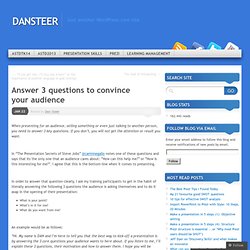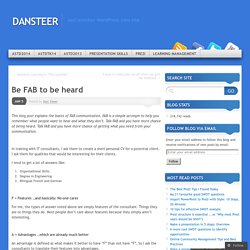

Create Strong Messages In Your Presentation. The only 3 questions that count. When presenting for an audience, selling something or even just talking to another person, you need to answer 3 key questions.

If you don’t, you will not get the attention or result you want. In “The Presentation Secrets of Steve Jobs” @carminegallo notes one of these questions and says that its the only one that an audience cares about: “How can this help me?” Or “How is this interesting for me?”. I agree that this is the bottom-line when it comes to presenting. In order to answer that question clearly, I ask my training participants to get in the habit of literally answering the following 3 questions the audience is asking themselves and to do it asap in the opening of their presentation: What is your point?
An example would be as follows: “Hi. Another example: “Thank you for joining the presentation. These 2 examples are quite different. So: Go forth and answer these question as soon as possible. Thanks for reading Follow me on Twitter Subscribe to the blog to get more presentation tips… Be FAB to be heard. This blog post explains the basics of FAB communication.

FAB is a simple acronym to help you remember what people want to hear and what they don’t. Talk FAB and you have more chance of being heard. Talk FAB and you have more chance of getting what you need from your communication. In training with IT consultants, I ask them to create a short personal CV for a potential client. I ask them for qualities that would be interesting for their clients. I tend to get a lot of answers like: Organisational SkillsDegree in EngineeringBilingual French and German F = Features …and basically: No-one cares For me, the types of answer noted above are simply features of the consultant. A = Advantages …which are already much better An advantage is defined as what makes it better to have “F” than not have “F”. This is what I get (respectively, for the aforementioned “F” answers): Already much better!! B = Benefits …and this is what people care about In fact, let me slow down a bit. 3 more examples: In conclusion… Adapt to learning styles.
We have some very exciting plans for Businessballs.

Later this month, we will be launching a new visual identity, refreshing the design of the site and adding lots of new functionality to enhance your learning experience. Phase 2 will include badges, learning plans linked to accredited competency frameworks, wikis (for collaborative content development) and new content from international thought leaders and academics.
The site will continue to follow our ethos of free work and life learning, and the redevelopment and ongoing management will be delivered by our partner Accipio. If you are interested in contributing content or your view on where we should take businessballs next, please email ask@businessballs.com. David Kolb's learning styles model and experiential learning theory (ELT) Having developed the model over many years prior, David Kolb published his learning styles model in 1984. Accordingly - especially if you are working with young people - use systems and methods with care. Making a Message Persuasive: How to Keep People Focused. A strong opening is important to a persuasive appeal because it focuses the audience’s attention, but then what do you do to influence them the rest of the way?

The challenge in a persuasive message is to make it compelling enough that it will be memorable and will shape the reader or listener’s opinion or behavior. Here are a few tactics to make your persuasive message more effective: - Appeal to something the audience values. If you want someone to lead a recycling campaign in the office and you know a person who is a strong advocate for a clean environment, you might tailor your message accordingly. Or if employees value time off more than higher pay, then your message should emphasize that as part of the incentive. - Urge the audience to imagine a favorable outcome.
. - Include substantive information to support your argument. There are no trackbacks on this entry. Photo by dansteer.